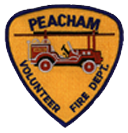Read “A Salute to the Peacham Fire Department”. This article also contains a list of Peacham Fire Chiefs. Current Members and Officers can be found under “About” “Members”.
Peacham’s Fire Department Keeps Up-to-Date
by David Brown – (c) 1997
with assistance from Fire Chief Jeff Berwick
Compared to 1950, when Peacham’s Fire Department was founded, town fire fighters today are trained differently, notified of fires differently, respond to different kinds of calls, and use different equipment to go about their work. One thing that remains the same is that all members of the department are volunteers, contributing a total of 1,250 hours a year in the line of duty.
At the present time [1997], the department has twenty members. They are:
Jeff Berwick, Chief since 1986
Allan Marceau, Assistant Chief
Dwayne Marceau, Captain
Allen Thresher, Captain/Engineer
Bill Thresher, Lieutenant
Arthur Noyes, Fire Police (responsible for traffic control)
Other members include:
Deborah Marceau
James Bradley
Jason Crocker
Bill Frey
Barry Hayes
Neil Monteith
Robert Ruffner
Richard Stokes
Dennis Tillotson
Richard Woodward
Richie Woodward
Mitch Kathan
and two Danville residents, Troy Cochran (member of Danville and Peacham departments) and Chris Nye
[Note: See a list of current officers and members.]
Department meetings follow a pattern, with Monday evenings devoted to business (first Mondays), training (third Mondays) and work nights. Basic training classes now take close to 90 hours, almost double what used to be the case. As a result, fire fighters are now trained to handle a variety of emergencies. Specialized training is required in use of the self-contained air pack, before a fire fighter can be certified to enter a smoke-filled building. In addition, members are expected to attend regional fire schools (at Blue Mountain Union School, for example). Since fighting fires is extremely hazardous, with over 100,000 injuries to fire fighters throughout the country per year, this training is very important to ensure that fire fighters do not expose themselves to unnecessary risks, as well as to see that fires are fought as efficiently as possible.
Readers may remember when Alice Hobart and Edith Smith, the operators for the Molly Falls Telephone Company, supplied 24-hour-coverage, and the party-line system meant that news of a fire got around quickly. When dial phones arrived, they brought a phone change system which did not always work quite as well, and timely notification was not always possible. Today, emergency calls go to the St. Johnsbury Fire Department, which is staffed 24 hours a day. [Note: In an emergency Dial 911] Every member of the Peacham department has a pager, which allows the St. Johnsbury dispatcher to send a voice message giving specifics as to location and type of fire, or other problem. In the case of the Chandlers’ fire this past summer, fire fighters were on the scene within ten minutes of receiving the summons via pager, and that was at three o’clock in the morning!.
As part of a mutual aid system, the Peacham department usually responds to 10 to 15 calls a year, for structure fires only, in Danville, Groton, Barnet, and Ryegate. There is also a cooperative agreement with St. Johnsbury and Lyndonville.
Chief Berwick reports changes in the types of calls the department makes, too. For example the number of chimney fires has decreased. In 1996, there were only 6, a decrease from an average of 12, which the Chief attributes to less wood being burned, and so less creosote buildup to catch fire. The department is prepared to handle hazardous material incidents, which did not often require department assistance in the past, and carbon monoxide testings, which are done with equipment not available in the past. The department recently purchased a carbon monoxide detector, which in addition to allowing the situation at a fire to be assessed accurately, can be used to test the air in homes where the danger of carbon monoxide poisoning may be a concern.
In 1996, the department responded to 28 emergencies:
Chimney fires 6
Structure fires 2
Forest fires 3
Power lines 2
False alarms 2
Car fires 1
Dryer fire 1
Motor vehicle accidents 2
Carbon monoxide detector 1
Mutual aid 8
Chief Berwick urges all residents to install smoke detectors, and to check them regularly, once a month. Batteries should be changed once a year. Many people replace their batteries when Daylight Savings Time ends.
When Gib Randall was the first Chief, in 1950, the department purchased the famous 1946 Willys Jeep fire truck. It had been built for use at sawmills, and there was some question as to how effective it would be in Peacham. The test was whether or not it could shoot water over Warren Farrington’s barn. It passed the test.
The current pumper is comprised of a 1977 Darley pump and body and a 1989 Ford cab and chassis. It is capable of pumping 750 gallons per minute. The department has a dry hydrant, which reaches water below the frost line, much the way a frost free spigot works at home, to guarantee an adequate water supply year-round. In addition, the department has a portable Class A foam unit, which mixes water with foam to smother a fire. The foam also penetrates wood, so it can protect threatened surfaces. Foam can be used on grass as well as structure fires.
No doubt fire fighting 47 years in the future will differ from what is done today as markedly as current practices differ from what was available when the department began its service to the town, 47 years ago, but without question the people of Peacham will continue to value the quick response, professionalism, bravery and kindness of the men and women of its fire department.

